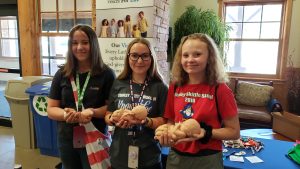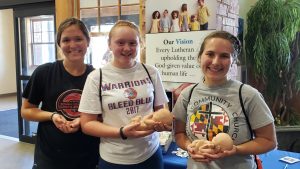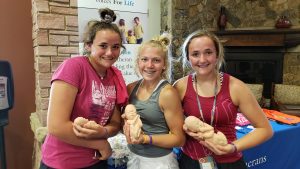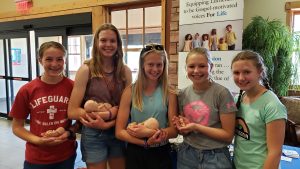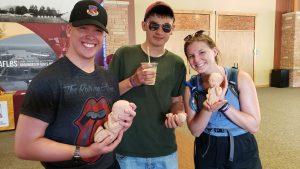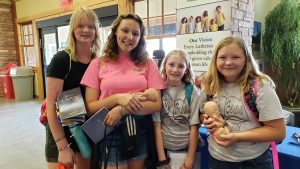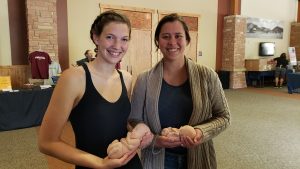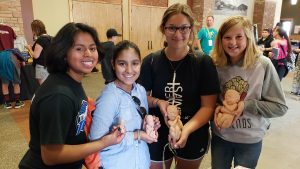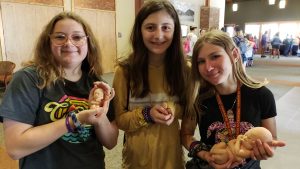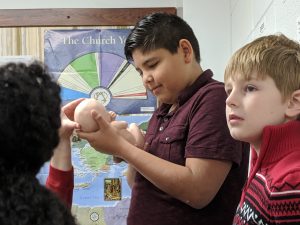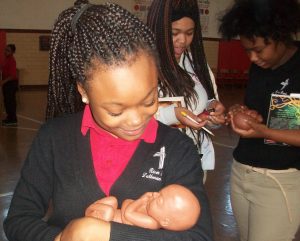
by Pastor Michael Salemink
 They never fail to smile.
They never fail to smile.
For years, we’ve been using the Touch of Life fetal models in our education and advocacy. (You can learn more about this on our Owen′s Mission page.) Heritage House ’76 (www.pro.life)—the same folks who designed the “Precious Feet” lapel pins—produces them by hand in Snowflake, Arizona. The designs have been sculpted to correspond with medical accuracy to real-life photographs of babies in the womb at particular stages of development. And the artisans make them from a biosynthetic gel silicone that has the same density as the human body. This gives them a weight that matches their size as well as the softness of skin and the give of lifelike tissue. They come in your choice of three skin tones (black, brown, and white) and include a supply of baby powder. (Handling eventually gets them dirty; washing and drying gets them sticky; powdering prevents the irritation.) We sometimes mix multiple skin tones in a single set, and we carry them in an aluminum case that protects them during transport while speaking to the value its contents represent.
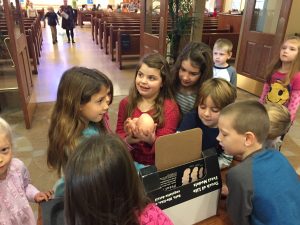
The littlest of the set that we display embodies baby at twelve weeks gestation. She measures two-and-a-half inches long, weighs about an ounce, and fits in the palm. She has all the same anatomical elements as you and I do but smaller. Her next older brother takes up the whole hand, and at sixteen weeks stretches four-and-a-half inches with a weight of about five ounces. The third, by twenty-two weeks, has grown to about one-and-a-half pounds and seven-and-a-half inches, and he requires two hands to hold. About fifty percent of little ones born prematurely at this age will survive with intensive care (including the youngest ever recorded—twenty-one weeks and three days!). Their oldest sister has reached nine-and-a-quarter inches in her twenty-six weeks since fertilization, and she tips the scales at about two-and-a-half pounds. She needs to be cradled with both arms.
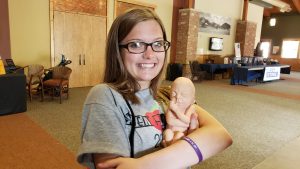
Somehow the children who interact with us know this. From the tiniest toddlers to the toughest teens to the university students, they cannot resist the instinct to touch and lift and embrace. Of course, some poke the heads or squeeze the bellies, absolutely fascinated by just how much the small figures squish. Some comment that they look like “space aliens” because of the faces so prominently disproportionate to the rest of the members. But nobody tosses or drops the models. They may keep an apprehensive distance at first, respectful of the fragility and responsibility involved, they may pick one up between thumb and forefinger as if retrieving a banana peel, but they always end up rocking them just like a loving mother does.
 They have to get their hands on each of the four. They have their pictures taken while snuggling them. Most of them reflexively support the neck and cranium (even though the models have somewhat studier necks than their living counterparts). They hold them to their abdomen and wonder, “How can this fit in there?” or suppose “this is what I would look like pregnant.” (Young women with child do this quite often to gauge the size of what’s hiding inside.) They even kiss them on the brow and lay them gently back into the container (lined, after all, with a swaddling cloth).
They have to get their hands on each of the four. They have their pictures taken while snuggling them. Most of them reflexively support the neck and cranium (even though the models have somewhat studier necks than their living counterparts). They hold them to their abdomen and wonder, “How can this fit in there?” or suppose “this is what I would look like pregnant.” (Young women with child do this quite often to gauge the size of what’s hiding inside.) They even kiss them on the brow and lay them gently back into the container (lined, after all, with a swaddling cloth).
 And they never fail to smile. Misty-eyed grandparents, goofy adolescents, and giggling preschoolers all grin at the sight and the sensation. It isn’t the lumps of rubber that make such a lasting impression but rather the Word and the work and the worth of the Lord God Almighty that they proclaim. They have the shape, the weight, the fragrance, and the feel of a story, a relationship, a privilege, a purpose. They replicate and ready us for an encounter with something sacred: the miracle of human life, each one intimately and meticulously created, redeemed, called by the gracious labor of the Heavenly Father.
And they never fail to smile. Misty-eyed grandparents, goofy adolescents, and giggling preschoolers all grin at the sight and the sensation. It isn’t the lumps of rubber that make such a lasting impression but rather the Word and the work and the worth of the Lord God Almighty that they proclaim. They have the shape, the weight, the fragrance, and the feel of a story, a relationship, a privilege, a purpose. They replicate and ready us for an encounter with something sacred: the miracle of human life, each one intimately and meticulously created, redeemed, called by the gracious labor of the Heavenly Father.
Thank you for allowing us and assisting us to deliver this gift.
